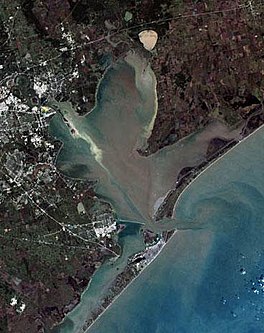| Galveston Bay | |
|---|---|
 Satellite image of Galveston Bay. Galveston Island is at the bottom of the image, separated from Bolivar Peninsula by Bolivar Roads. A portion of Greater Houston is visible to the left. | |
| Location | Texas Gulf Coast |
| Coordinates | 29°34′11″N 94°56′12″W / 29.56972°N 94.93667°W |
| Primary inflows | Trinity River, San Jacinto River |
| Ocean/sea sources | Gulf of Mexico |
| Basin countries | United States |
| Max. length | 30 miles (48 km) |
| Max. width | 17 miles (27 km) |
| Surface area | 345,280 acres (139,730 ha)[1] |
| Average depth | 6 feet (1.8 m) |
| Max. depth | 10 feet (3.0 m) |
| Settlements | Houston, Pasadena, League City, Baytown, Texas City, Galveston, La Porte, Seabrook, Anahuac |
Galveston Bay (/ˈɡælvɪstən/ GAL-vis-tən) is a bay in the western Gulf of Mexico along the upper coast of Texas. It is the seventh-largest estuary in the United States,[2] and the largest of seven major estuaries along the Texas Gulf Coast. It is connected to the Gulf of Mexico and is surrounded by sub-tropical marshes and prairies on the mainland.[3] The water in the bay is a complex mixture of sea water and fresh water, which supports a wide variety of marine life. With a maximum depth of about 10 feet (3 m) and an average depth of only 6 feet (2 m), it is unusually shallow for its size.
The bay has played a significant role in the history of Texas. Galveston Island is home to the city of Galveston, the earliest major settlement in southeast Texas and the state's largest city toward the end of the nineteenth century.[4] While a devastating hurricane in 1900 hastened Galveston's decline, the subsequent rise of Houston as a major trade center, facilitated by the dredging of the Houston Ship Channel across the western half of the bay, ensured the bay's continued economic importance.[5]
Today, Galveston Bay is encompassed by Greater Houston, the fifth-largest metropolitan area in the United States.[6] The Port of Houston, which has facilities spread across the northwestern section of the bay, is the second-busiest port in the nation by overall tonnage.[7] Other major ports utilizing the bay include the Port of Texas City and the Port of Galveston. With its diverse marine life, Galveston Bay also produces more seafood than any estuary in the United States except the Chesapeake.[8]
- ^ "Trinity–San Jacinto Estuary (Galveston Bay)". Texas Water Development Board. Retrieved February 7, 2020.
- ^ Pulich Jr., Warren (2002). "Seagrass Status and Trends in the Northern Gulf of Mexico: Galveston Bay System" (PDF). United States Geological Survey. Retrieved March 29, 2020.
- ^ Eubanks, Behrstock & Weeks (2006), pp. 10–11
- ^ McComb, David G. (June 15, 2010). "Galveston, TX". Handbook of Texas Online. Texas State Historical Association. Retrieved March 29, 2020.
- ^ "J.H.W. Stele to Sayers, September 11–12, 1900". Texas State Library and Archives Commission. Retrieved March 29, 2020.
- ^ Lawhorn, Valerie (March 24, 2016). "Census Numbers Are Out: Greater Houston Area Has Largest Population Gain". Houston Public Media. Retrieved March 29, 2020.
- ^ Collier, Kiah (May 3, 2013). "Houston has the busiest seaport in the U.S." Houston Chronicle. Retrieved March 29, 2020.
- ^ "Galveston Bay Estuary Program EPA/State Management Conference Agreement: Introduction" (PDF). Galveston Bay Estuary Program. September 1989. Archived from the original (PDF) on 2022-04-12. Retrieved 2020-03-29.
